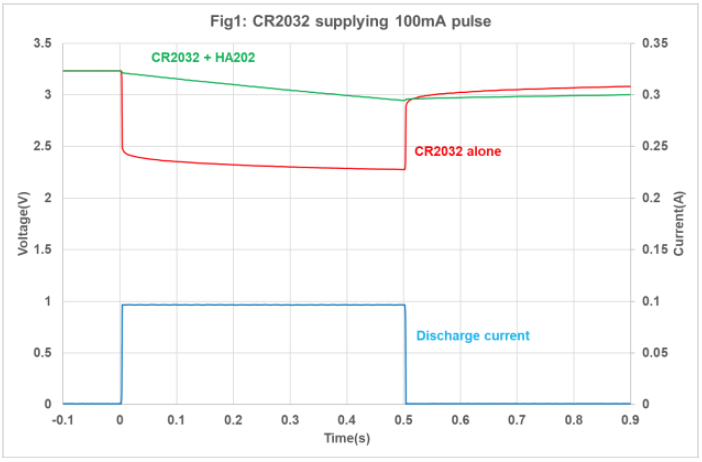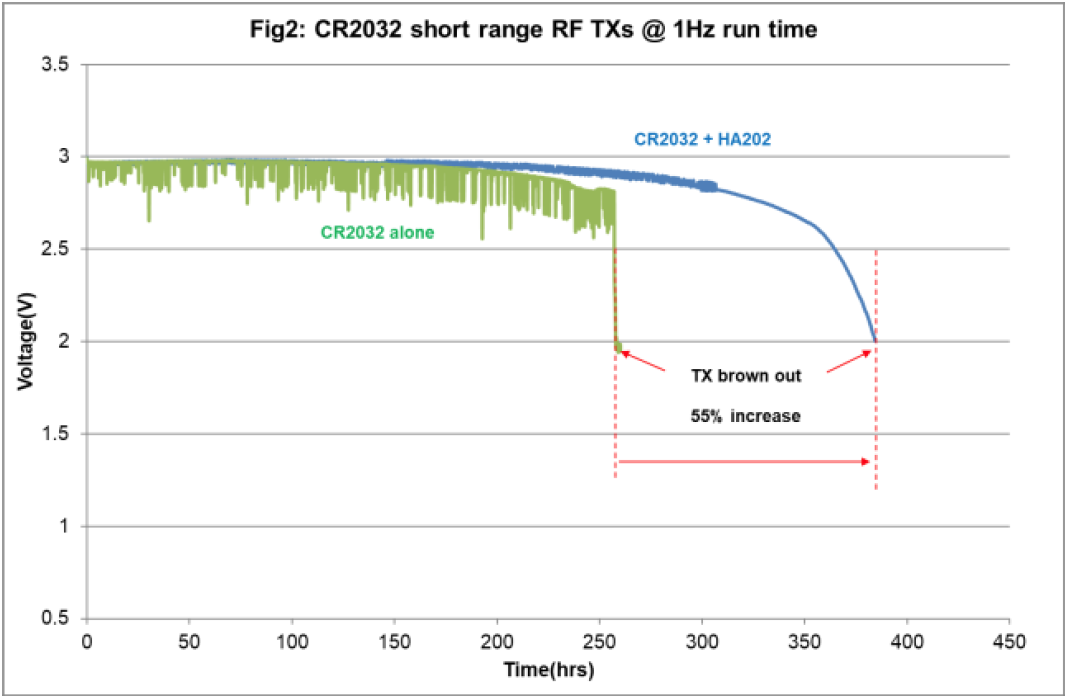Supercapacitors provide peak power
A supercapacitor stores far more energy than traditional batteries and has far superior power delivery to batteries that are limited by the rate of a chemical reaction, or energy harvesters that are limited by ambient power. In applications where significant energy with high peak power is required, a supercapacitor can be the perfect solution.
Supercaps deliver peak power for data transmission, solenoid activation, e-ink update, LED flash etc.
Peak or pulse power loads in an application occur when the peak power is >> average power. The peak bursts occur for a short duration between longer intervals at low power. The energy source, such as a battery or energy harvester can supply the average power but not the peak, which the supercapacitor delivers. Examples include data transmission, activating a solenoid for door locks or for closing or opening a valve, activating a motor for haptic feedback, or to drive a pump for insulin injection or other drug delivery, high power LED Flash, scanners, updating an e-ink display. These actions occur at low duty cycle, with long periods of low power consumption between peak busts. Consider an example of cellular data transmission using LTE CAT M1, which requires 0.2A at 3.6V for NB IoT for 50ms every 60secs, and the power drawn between transmissions is 0.1mA. Then the peak power = 0.72W but average power = (0.72W x 0.05s + 0.36mW x 60s)/60.05s = 0.96mW. A low power energy source such as a coin cell or micro energy harvester can charge the supercapacitor at ~1mW while the supercapacitor provides the 0.72W peak.
APPLICATON BRIEF
AB1025 Rev 2.4
Supercapacitors Provide Peak Power
A supercapacitor stores electrical energy as physical charge in an electric field, giving it far superior power delivery to batteries that are limited by the rate of a chemical reaction, or energy harvesters that are limited by ambient power. A supercapacitor stores orders of magnitude more energy than traditional capacitors. In applications where significant energy with high pulse power is required, a supercapacitor can be the perfect solution.
Definition of a peak power load
Peak power loads in an application occur when the peak power is >> average power. The peak bursts occur for a short duration between longer intervals at low power. The energy source, such as a battery or energy harvester can supply the average power but not the peak, which the supercapacitor delivers.
The blue trace in Fig1 is the 100mA load current of a wireless transmission pulse with standby current in the micro amps. If it is sent 1/minute the average current is ~0.85mA << the 100mA. This is an example of a peak load. The energy source can easily provide the 0.85mA to charge the supercapacitor between pulses and the supercapacitor easily delivers the 100mA peak.
LED flash, wireless transmission, e-ink display update and electromechanical actuators such as e-locks are good examples of peak power loads.

Supercapacitors support peak power with a battery
Design constrains in the application may dictate the need of a smaller battery such as a coin cell or batteries with the highest energy density possible. These batteries may have trouble delivering the peak power, or may suffer from severely reduced battery life when supplying the full peak power.
For example, an application primarily uses a CR2032 Lithium battery to drive a radio module. Fig 1 is a 100mA, 0.5s pulse typical of a radio transmission drawn from a CR2032 battery alone (Red), and a CR2032 battery paired with a HA202 supercapacitor, 120mF, 120mΩ (Green). A typical CR2032 battery has an internal resistance, IR = ~10Ω. During the 100mA pulse the battery voltage droop is around 1V dropping to 2.25V. This voltage level is approaching the minimum operating voltage of the electronics, and the battery is brand new. This will likely cause data transmission to fail, especially when the battery ages. However once paired with an HA202 the CR2032 voltage droop is reduced to only 0.2V, keeping the supply voltage to ~3V after one pulse. This is because the supercapacitor has very low ESR (~120mΩ for HA202) provides most of the peak current and the voltage droop = ILOAD x ESR = 0.5A x 120mΩ = 60mV + voltage drop due to supercapacitor discharge.
Using a supercapacitor to provide the peak power, more energy can be extracted from a battery. Fig 2 is an accelerated test with two CR2032 batteries, one by itself (Green), and the other coupled with an HA202 supercapacitor (Blue), both are powering a short range BLE TX module with 15mA peak current. The tests ran until module brown-out. As the battery depletes, the internal resistance increases beyond 60Ω. Drawing 15mA sees the battery voltage drop to ~2V, causing the module to brown out even though there is still plenty of energy left in the battery. Fig 2 shows that the CR2032 paralleled with an HA202 is still ~2.8V when the unsupported battery fails. This reduced voltage drop allowed the BLE Tx to utilise nearly all the energy in the battery before brown-out, greatly extending battery life. Again, this is due to the reduced voltage droop due to the low supercapacitor ESR.

Supercapacitor support pulse power with energy harvester
An energy harvester may theoretically allow the application to run indefinitely but energy harvesters such as small solar cells or micro generators that fit a size constraint are often only able to supply current in the order of µA and may not be able to supply the peak power needed. In such cases even a load in the mA range would be considered a peak power load.
A supercapacitor is the perfect power buffer. The energy harvester charges the supercapacitor directly or through a power management IC at a low power. Once charged the supercapacitor provides the peak power burst for any pulse load while maintaining a steady supply voltage, effectively decoupling the low power energy harvesting source from the load peaks enabling successful operation of the electronics.
For more detailed information please see:
Our latest range of supercapacitors, DMF low ESR high power, DMT long life high temp or DMH ultra-thin supercapacitors.
Powering Pulsed Loads
Coupling a Supercapacitor with a Battery
Supercapacitor Inrush Current Limiting
Supercapacitor Cell Balancing
The following whitepapers describe energy harvesting applications:
Solar cells to power sensors (Charging a Supercapacitor with Vibration energy harvester).
RF for rapid wireless charging of a supercapacitor (Wireless Charging).
Vibration transducers (micro-generator or piezo electric) to power sensors (Charging a Supercapacitor with Vibration energy harvester).


